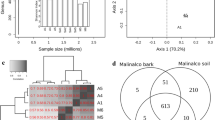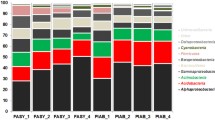Abstract
The purpose of this study was to establish the myxobacterial biodiversity of an established oak-hickory forest and a savanna restoration site that has been cut and subsequently burned on four occasions between 1993 and 1998 in an attempt to restore the land to the native savanna ecosystem. Soil and bark samples were processed through standard methods specifically for myxobacteria and numbers and types of species were recorded for both locations. Species were identified through morphology of fruiting bodies, SDS-PAGE of whole cell protein profiles, and 16S rRNA gene sequences. Statistical analyses were employed and suggested that significantly greater numbers and types of myxobacteria are present on the bark of the trees in the established oak-hickory forest than the bark of trees in the savanna restoration site, while little difference in numbers and types of species were observed between the soil samples of the two locations.



Similar content being viewed by others
Literature Cited
ER Brockman (1976) ArticleTitleMyxobacters from arid Mexican soil Appl Environ Microbiol 32 642–644
W Dawid (2000) ArticleTitleBiology and global distribution of myxobacteria in soils FEMS Microbiol Rev 24 403–427 Occurrence Handle10.1016/S0168-6445(00)00032-2
Felsenstein J (2004) PHYLIP (phylogenetic inference package), Version 3.6.1. Department of Genetics, University of Washington, Seattle
D Goldman SA Sedman MH Ebert (1981) ArticleTitleUltrasensitive stain for proteins in polyacrylamide gels shows regional variation in cerebrospinal fluid proteins Science 211 1437–1438
CJ Krebs (1989) Ecological methodology Harper and Row Publishers New York
Magers V (1997) Storehouses of natural diversity. The World and I. April p. 198–203
McCarty K (1992) Restoration in Missouri’s savannas. Jefferson City, MO: Missouri Department of Natural Resources
HD McCurdy (1971) ArticleTitleStudies on the taxonomy of the Myxobacteriales III. Chondromyces and Stigmatella Int J Syst Bacteriol 21 40–49
HD McCurdy (1989) Order Myxococcales Tchan, Pochon, and Prevot 1948, 398 JT Staley MP Bryant N Pfennig JG Hold (Eds) Bergey’s manual of sysematic bacteriology, Vol. 3 Williams & Wilkins Baltimore 2139–2170
HD McCurdy BT Khouw (1969) ArticleTitleStudies on Stigmatela brunnea Can J Microbiol 15 731–738
O’Dell RB, Wilson PK (1995) Changing perspectives of Missouri prairies: presettlement to late-twentieth century. Transactions of Missouri Academy of Science
JE Peterson (1959) ArticleTitleNew species of myxobacteria from the bark of living trees Mycologia 51 163–172
JE Peterson (1965) ArticleTitleA group of strongly cellulolytic myxobacteria from the bark of living trees Am J Botany 52 636
JE Peterson (1969a) ArticleTitleThe fruiting myxobacteria: their properties, distribution, and isolation J Appl Bact 32 5–12
JE Peterson (1969b) Isolation, cultivation, and maintenance of the myxobacteria JR Norris DW Ribbims (Eds) Methods in microbiology, Vol 3B Academic Press New York 185–210
H Reichenbach (1993) Biology of the myxobacteria: ecology and taxonomy M Dworkin D Kaiser (Eds) Myxobacteria II American Society for Microbiology Washington, DC 13–61
H Reichenbach M Dworkin (1992) Introduction to the gliding bacteria; the order Myxobacteriales M Starr H Stolp HG Truper A Balows HG Schlegel (Eds) The prokaryotes Springer-Verlag New York 315–355
Ritchey CM (1999) The effect of anthocyanin on herbivory in Viola pedata (Birdfoot Violet). M.S. Thesis. Truman State University, Kirksville, MO
A Rosenbluh E Rosenberg (1993) Developmental lysis and autocides M Dworkin D Kaiser (Eds) Myxobacteria II American Society of Microbiology Washington, DC 213–233
Schroeder WA (1983) Presettlement prairie of Missouri. Jefferson City, MO: Missouri Department of Conservation
L Shimkets CR Woese (1992) ArticleTitleA phylogenetic analysis of the myxobacteria: basis for their classification Proc Natl Acad Sci USA 89 9459–9463
BN Singh NB Singh (1971) ArticleTitleDistribution of fruiting myxobacteria in Indian soils, bark of trees, and dung of herbivorous animals Ind J Microbiol 11 47–92
RR Sokal FJ Rohlf (1995) Biometry EditionNumber3 W.H. Freeman and Company New York
C Sproer H Reichenbach E Stackebrandt (1999) ArticleTitlethe correlation between morphological and phylogenetic classification of myxobacteria Int J Syst Bacteriol 49 1255–1262
Toney TE (1993) Public prairies of Missouri. Jefferson City, MO: Missouri Department of Conservation
United States Department of Agriculture. 1997. Soil survey of Adair County, Missouri. Public Domain
P Vandamme B Pot M Gillis P Vos ParticleDe K Kersters J Swings (1996) ArticleTitlePolyphasic taxonomy, a consensus approach to bacterial systematics Microbiol Rev 60 407–438 Occurrence Handle1:CAS:528:DyaK28XktVejtbc%3D Occurrence Handle8801440
Acknowledgments
Special thanks are extended to the Missouri Department of Natural Resources for letting us work on their land, Lisa Hooper and Jeffery Osborn of Truman State University who aided in tree species identification and the use of microscopes, Lawrence Shimkets of the University of Georgia for lending us reference strains, and Rolf Müller of GBF Gesellschaft für Biotechnologische Forschung mbH for giving us the primer sequences.
Author information
Authors and Affiliations
Corresponding author
Rights and permissions
About this article
Cite this article
Neil, R.B., Hite, D., Kelrick, M.I. et al. Myxobacterial Biodiversity in an Established Oak-Hickory Forest and a Savanna Restoration Site. Curr Microbiol 50, 88–95 (2005). https://doi.org/10.1007/s00284-004-4406-4
Received:
Accepted:
Published:
Issue Date:
DOI: https://doi.org/10.1007/s00284-004-4406-4




